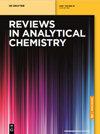电化学检测系统中最小化污垢的最新策略
IF 3.8
3区 化学
Q2 CHEMISTRY, ANALYTICAL
引用次数: 167
摘要
电极结垢是一种严重影响技术或传感器分析特性的现象,如灵敏度、检出限、重现性和整体可靠性。电极结垢通常涉及由结垢剂对电极表面的钝化,该结垢剂在电极上形成越来越不渗透的层,抑制感兴趣的分析物与电极表面的直接接触以进行电子转移。一些潜在的污染物质包括蛋白质、酚类、氨基酸、神经递质和其他生物分子。各种防污策略已经被报道来减少或消除电极污染。大多数防污策略利用电极衬底上的保护层或屏障来防止污垢剂到达电极表面。虽然这样的策略可以是相当有效的,他们是不合适的系统中,分析物本身也是污垢剂。在这种情况下,必须使用其他策略,包括电极表面改性和电化学活化。在这篇综述中,最近的策略,以尽量减少和努力克服电极污染的各种分析物和污染剂将被提出。本文章由计算机程序翻译,如有差异,请以英文原文为准。
Recent strategies to minimise fouling in electrochemical detection systems
Abstract Electrode fouling is a phenomenon that can severely affect the analytical characteristics of a technique or a sensor, such as sensitivity, detection limit, reproducibility, and overall reliability. Electrode fouling generally involves the passivation of an electrode surface by a fouling agent that forms an increasingly impermeable layer on the electrode, inhibiting the direct contact of an analyte of interest with the electrode surface for electron transfer. Some potential fouling agents include proteins, phenols, amino acids, neurotransmitters, and other biological molecules. Various antifouling strategies have been reported to reduce or eliminate electrode fouling. Most antifouling strategies exploit a protective layer or barrier on an electrode substrate to prevent the fouling agent from reaching the electrode surface. Although such strategies can be quite effective, they are inappropriate for systems in which the analyte itself is also the fouling agent. In such cases, other strategies must be used, including electrode surface modification and electrochemical activation. In this review, recent strategies to minimise and efforts to overcome electrode fouling across a diverse range of analytes and fouling agents will be presented.
求助全文
通过发布文献求助,成功后即可免费获取论文全文。
去求助
来源期刊

Reviews in Analytical Chemistry
化学-分析化学
CiteScore
7.50
自引率
0.00%
发文量
15
审稿时长
>12 weeks
期刊介绍:
Reviews in Analytical Chemistry publishes authoritative reviews by leading experts in the dynamic field of chemical analysis. The subjects can encompass all branches of modern analytical chemistry such as spectroscopy, chromatography, mass spectrometry, electrochemistry and trace analysis and their applications to areas such as environmental control, pharmaceutical industry, automation and other relevant areas. Review articles bring the expert up to date in a concise manner and provide researchers an overview of new techniques and methods.
 求助内容:
求助内容: 应助结果提醒方式:
应助结果提醒方式:


